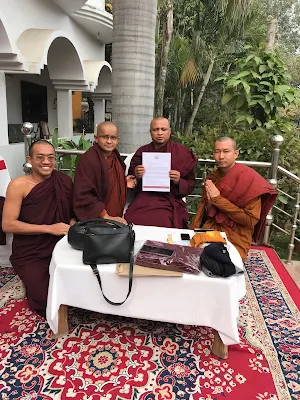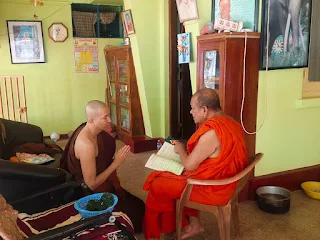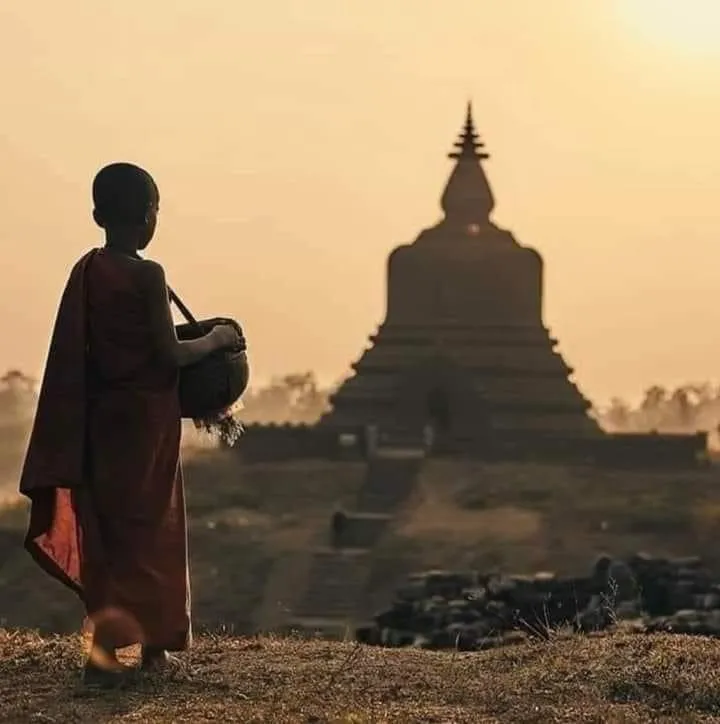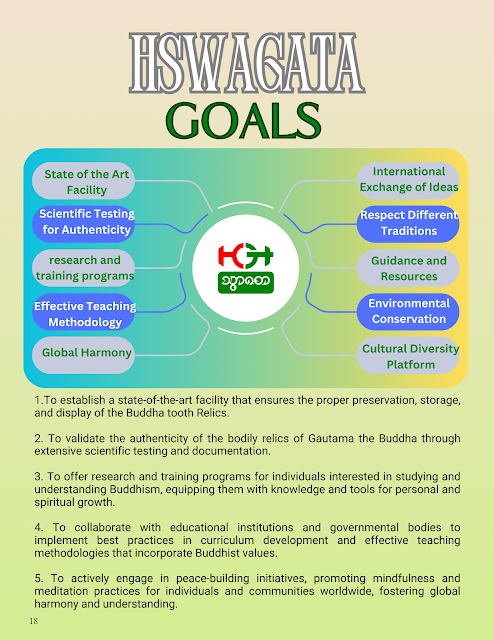Anekajātisaṃsāraṃ sandhāvissaṃ anibbisaṃ gahakāraṃ gavesanto dukkhā jāti punappunaṃ Gahakāraka diṭṭho'si puna gehaṃ na kāhasi sabbā te phāsukā bhaggā gahakūṭaṃ visaṅkhataṃ visaṅkhāragataṃ cittaṃ taṇhānaṃ khayamajjhagā (The Dhammapada, verses 153-154)
ဝန္ဒာမိ
Search This Blog
Total Pageviews
Tuesday, February 27, 2024
A POTENTIAL FUTURE COOPERATION
UNIVERSAL DECLARATION FOR INTERNATIONAL COOPERATION - WORSHIP THE BUDDHA REAL TOOTH .
We, the participants and stakeholders of this Universal Declaration for International Cooperation in Worshiping The Buddha Real Tooth and Peace, recognizing the importance of fostering mutual understanding, cultural exchange, and peaceful coexistence, hereby declare our commitment to the following principles:
1. Preservation and Protection:
We pledge to cooperate in the preservation and protection of The Buddha's Real Tooth, ensuring its safety and safeguarding it from any form of damage, theft, or illicit trade. We will work together to establish adequate security measures and promote awareness of its historical and spiritual significance to foster respect and reverence.
2. Sharing of Knowledge and Information:
We commit to sharing knowledge, research, and information related to The Buddha's Real Tooth, contributing to the scholarly exploration and understanding of its origins, history, and cultural significance. Open dialogue and the exchange of expertise will be encouraged to enhance collective knowledge and facilitate a deeper understanding of the relic's profound impact.
3. Cultural Exchange and Collaboration:
We recognize the power of cultural exchange and collaboration as means to promote mutual respect, tolerance, and understanding among nations. We will support initiatives that facilitate international exhibitions, seminars, festivals, and other cultural events centred around The Buddha's Real Tooth, encouraging people from diverse backgrounds to come together, learn, and appreciate its spiritual and historical heritage.
4. Education and Outreach:
We will encourage educational programs, workshops, and initiatives that disseminate accurate information about The Buddha's Real Tooth, its historical significance, and the teachings of Lord Buddha. These efforts will aim to foster a deeper understanding of Buddhist culture and values, promoting peace, harmony, and ethical conduct in societies.
5. Ethical Tourism and Pilgrimage:
Recognizing the importance of responsible tourism and pilgrimage related to The Buddha's Real Tooth, we commit to developing sustainable tourism practices that respect local communities, minimize environmental impact, and uphold ethical considerations. We will work together to create guidelines and initiatives that ensure the sanctity and integrity of the worship experience, while supporting local economies and cultural heritage
6.Preservation and Promotion:
We pledge to work collaboratively towards the preservation and promotion of The Buddha's Real Tooth, recognizing its cultural, historical, and spiritual significance. By safeguarding this relic, we aim to honor its heritage and promote peace through the teachings and principles embodied within Buddhism.
7. Interfaith Dialogue and Harmony:
We acknowledge the importance of interfaith dialogue and the promotion of religious harmony. We commit to fostering understanding and respect between different faith traditions, recognizing the value of diversity within our global community. Through peaceful dialogue and cooperation, we strive to build bridges of understanding and unity.
8. Cultivating Peaceful Mindsets:
We recognize the transformative power of peaceful mindsets in creating harmonious societies. We commit to promoting mindfulness, compassion, and non-violence as essential foundations for personal and collective well-being. By cultivating inner peace, we aspire to foster peace in our communities and the world at large.
9. Education and Awareness:
We commit to promoting education, awareness, and research related to The Buddha's Real Tooth and its role in inspiring peace. Through educational programs, workshops, and cultural events, we aim to raise awareness of Buddhist teachings, meditation practices, and nonviolence as pathways to achieving and sustaining peace.
10. Collaborative Initiatives:
We pledge to establish and promote international collaborative initiatives that bring together diverse stakeholders in the worship and preservation of The Buddha's Real Tooth. These initiatives will prioritize cultural exchange, interfaith dialogue, and the promotion of peace, fostering greater understanding and cooperation among nations and communities.
11. Sustainable Peace and Environmental Stewardship:
We recognize the interconnectedness between peace and environmental sustainability. We commit to adopting practices that promote both peace and environmental stewardship, such as sustainable tourism, responsible resource management, and respect for nature. By caring for our environment and promoting peace, we strive for a harmonious and sustainable future.
We, the undersigned, hereby pledge our commitment to upholding and implementing the principles outlined in this Universal Declaration for International Cooperation in Worshiping The Buddha Real Tooth and Peace.It is advisable to involve relevant stakeholders, experts, and religious leaders to ensure the inclusivity and effectiveness of the declaration.
Sao Dhammasami "Siridantamahāpālaka"
The Hswagata Buddha Relics Preservation Museum
18.02.2022
HSWAGATA BUDDHA TOOTH RELICS PRESERVATION MUSEUM MYANMAR 15 PRINCIPALS .
A Call to Global Unity: A Greeting from the Preserver of Buddha Relics
တဖုဿနှင့် ဘလ္လိက (သို့) တပုဿ နှင့် ဘလ္လိက
Hswagata Museum Chairperson Meets with Sri Lanka and Japan Relationship Working Group Secretary
In a significant step towards fostering international collaboration and advancing the cause of Buddhist heritage preservation, the chairperson of the Hswagata Buddha Tooth Relics Preservation Museum recently held a pivotal meeting with the secretary of the Sri Lanka and Japan Relationship Working Group Committee. The meeting, which took place in India, served as a platform to present updates on the preservation efforts of the Buddha Tooth Relics and to discuss Hswagata's ongoing activities.
The gathering underscored the shared commitment of nations towards safeguarding and promoting the rich cultural legacy encapsulated within the Buddha Tooth Relics. The presentation offered insights into the meticulous preservation strategies employed by Hswagata, highlighting the museum's dedication to upholding the sanctity and historical significance of these revered artifacts.
During the meeting, discussions centered on collaborative initiatives aimed at enhancing awareness and appreciation of Buddhist heritage on a global scale. The exchange of ideas and perspectives between the chairperson of Hswagata and the secretary of the Sri Lanka and Japan Relationship Working Group Committee served to strengthen bonds of mutual understanding and cooperation.
The secretary expressed keen interest in the preservation efforts undertaken by Hswagata and lauded the museum's commitment to promoting intercultural dialogue and understanding. Recognizing the symbolic importance of the Buddha Tooth Relics, both parties reaffirmed their shared resolve to uphold the values of peace, compassion, and spiritual enlightenment embodied by the relics.
The meeting served as a testament to the transformative power of collaboration in advancing cultural preservation agendas. By fostering meaningful partnerships and engaging in constructive dialogue, Hswagata and the Sri Lanka and Japan Relationship Working Group Committee aim to chart a course towards a future where Buddhist heritage is cherished and celebrated across borders.
As guardians of a priceless cultural legacy, the chairperson of Hswagata and the secretary of the Sri Lanka and Japan Relationship Working Group Committee remain committed to working hand in hand to ensure that the wisdom and teachings encapsulated within the Buddha Tooth Relics continue to inspire and uplift humanity for generations to come.
The importance of seeing things as they truly are (yathābhūta ñāṇadassana)
When knowing feeling (vedanā), when you label it as "feeling," the five aggregates are already included, aren't they? Then, doesn't wrong view fall away? Doesn't doubt cease? When knowing impermanence, do you still see the five aggregates, or do you see their non-existence? You see their non-existence.
Isn't it taught to know what's not there? Isn't it taught to know what replaces it? Non-existence is anicca (impermanence), replacement is saṅkhāra (formations), isn't that what's taught? When feeling ceases, isn't it replaced by new feeling? When perception ceases, isn't it replaced by new perception?
When volition ceases, isn't it replaced by new volition? When consciousness ceases, isn't it replaced by new consciousness? When form ceases, isn't it replaced by new form? Isn't this worth examining?
This is the resultant process, the aggregates of resultant round (vipāka vaṭṭa khandha). This is what needs to be known. Can what needs to be known be eliminated? No, it cannot be eliminated. Isn't it taught as knowing and eliminating? You must know from the second square.
When there is knowing, does craving, clinging, and kamma still come in the third? They are eliminated. Isn't this worth contemplating? Study this thoroughly. So then, cessation of feeling (What ceases? Craving ceases, Venerable Sir), cessation of perception aggregate (Craving ceases, Venerable Sir).
Cessation of formations aggregate (Craving ceases, Venerable Sir), cessation of consciousness aggregate (Craving ceases, Venerable Sir), cessation of form aggregate (Craving ceases, Venerable Sir). This is called transcending feeling. Craving doesn't arise.
Whether you observe feeling until it disappears, or intensely observe pain, observe pain - after a while, feeling ceases. When feeling ceases, don't people say the body becomes light and experiences an incomparable coolness? Think about this.
Speaking based on hearsay about feeling ceasing and being replaced - these are resultant phenomena. Can they be eliminated? You can never make them disappear by trying. Yet people are trying to make them disappear.
They're trying to make disappear what cannot disappear. It will never work. Think about it. Isn't this worth examining? It's what needs to be known in the second (stage).
When you know the five aggregates, do you see people? Do you see what you find - is it people or the five aggregates? If you don't see people, will you see devas? Will you see brahmas? What you find - is it humans, devas, and brahmas, or the five aggregates? Don't you need to distinguish between what you see and what you think? What you think is humans, devas, and brahmas. What you find is the five aggregates. Isn't this taught as Ñāta Pariññā (knowledge of the known)? Isn't this worth examining? Think about it.
Looking further, don't these aggregates arise and pass away? When seeing arising and passing, do you see aggregates or their non-existence? Non-existence means impermanence. Isn't it taught that "non-existence is impermanence, knowing is path"? The characteristic of impermanence is suffering truth, the characteristic of suffering is suffering truth, the characteristic of non-self is suffering truth. Is this pleasant or suffering? This must be known.
When knowing it as suffering, does the wrong perception of human happiness, deva happiness, brahma happiness still come? Now you know the truth. You need to know it as suffering. Isn't it taught that knowing eliminates? Does craving, clinging, and kamma still come? They're eliminated. Isn't it taught as knowing and eliminating? This needs to be studied.
Existing phenomena cannot be made to disappear in any way. Isn't it taught that feeling ceases and is replaced, perception ceases and is replaced, volition ceases and is replaced, consciousness ceases and is replaced, form ceases and is replaced? The cessation of defilements is primary. Isn't this worth studying? Think about it.
Isn't it worth asking what these defilements are? Wrong perception. Isn't it wrong to perceive the five aggregates as beings? That's ignorance. Don't these five aggregates arise and pass away? Which truth is this? (It's the truth of suffering, Venerable Sir).
Is it human happiness or suffering truth? Deva happiness or suffering truth? Brahma happiness or suffering truth? Does the ignorance that wrongly perceives this suffering truth as human, deva, or brahma happiness cease or not? Worth considering. Ignorance is ceasing. Isn't this worth examining?
When knowing the truth, knowing it as suffering, doesn't the wrong perception of human, deva, and brahma happiness disappear? When truth is known, doesn't falsity disappear? This is what's taught.
This point needs to be known again and again and again. The wrong view has disappeared. Does craving, clinging, and kamma still come? Aren't the three types of dependent origination cut off? When cut off, will there be future aggregates? Isn't this taught as the Truth of Cessation? This needs to be studied...
Dr. Kalayan Priya Appointed Patron of Hswagata Buddha Tooth Relics Preservation Museum
In a significant development for the preservation and advancement of Buddhist heritage, Dr. Kalayan Priya, the esteemed abbot of the Bangladesh Buddhist Monastery in Gaya, India, has been appointed as the Patron of the Hswagata Buddha Tooth Relics Preservation Museum. This prestigious appointment comes with the vital role of providing guidance and fostering international relationships to further the museum's mission.
The decision to appoint Dr. Kalayan Priya as the Patron was made by the chairperson of Hswagata in December 2023, highlighting his exceptional contributions to the field of Buddhist studies and his dedication to promoting cultural understanding.
The Hswagata Buddha Tooth Relics Preservation Museum stands as a symbol of reverence and historical significance, housing relics that hold profound spiritual value for Buddhists worldwide. Located in a serene setting, the museum serves as a beacon for those seeking to deepen their understanding of Buddhism and its rich heritage.
Dr. Kalayan Priya's appointment brings with it a wealth of experience and knowledge, garnered through years of scholarly pursuit and spiritual practice. As the abbot of the Bangladesh Buddhist Monastery, situated in the heart of Gaya, a place revered by Buddhists as the site of the Buddha's enlightenment, Dr. Kalayan Priya embodies the spirit of reverence and devotion that lies at the core of Buddhist teachings.
His role as the Patron of the Hswagata Buddha Tooth Relics Preservation Museum underscores the museum's commitment to fostering strong ties with the global Buddhist community and promoting dialogue and exchange across cultural boundaries. Through his guidance, the museum aims to enrich its programs and initiatives, offering visitors a deeper insight into the significance of the relics housed within its walls.
Dr. Kalayan Priya's appointment heralds a new chapter in the museum's journey, one marked by collaboration, innovation, and a steadfast commitment to preserving and promoting Buddhist heritage for generations to come. As Patron, he will play a pivotal role in shaping the museum's vision and ensuring its continued success as a center of learning and spiritual enrichment.
With Dr. Kalayan Priya at the helm, the Hswagata Buddha Tooth Relics Preservation Museum looks forward to a future filled with promise and possibility, where the wisdom and teachings of the Buddha continue to inspire and enlighten all who walk through its doors.
Monday, February 26, 2024
Why Bhikkhu Indasoma Siridantamahāpālaka planned to go Siri Lanka?
Bhikkhu Indasoma Siridantamahāpālaka planned to go to Sri Lanka in February of 2024 for a specific purpose related to the preservation of Buddha Tooth Relics. The decision stemmed from an encounter in Gaya, December 2023 ,India, during the International Sangha Forum, where a Myanmar Sangha Delegation Group, led by Sangha Mahanayaka Venerable Ashin Kon Din Nya and accompanied by counselors, attended. During this forum, they interacted with the Hswagata Founder, who likely shared insights into the preservation work concerning the Buddha Tooth Relics.
Upon learning about the preservation efforts, a senior monk within the Myanmar Sangha delegation suggested to Ashin Indasoma (also known as Ashin Dhammasami) that he should visit Sri Lanka. The purpose of this visit was to meet with the Sangha Raja (the highest-ranking monk) of Sri Lanka and the management team responsible for the Buddha Tooth Relics Temple. The objective was to report on the progress of DNA confirmation related to the preservation efforts.
Therefore, Ashin Indasoma embarked on this journey to Sri Lanka to meet with the relevant authorities and present detailed information about the activities undertaken by Hswagata in the preservation of the Buddha Tooth Relics. This visit likely aimed to strengthen collaboration and exchange knowledge between Myanmar and Sri Lanka regarding this significant aspect of Buddhist heritage preservation.
Sunday, February 25, 2024
Q. What are the future plans for your organization?
The future plans for our organization encompass several key areas aimed at promoting peace, preserving relics, and advancing human rights based on Buddhist philosophy and teachings:
Preservation and Global Engagement: We aspire to engage with the global community in preserving Buddhist relics and cultural heritage. Through collaboration with international organizations, museums, and cultural institutions, we seek to raise awareness about the significance of relics and foster appreciation for Buddhist traditions worldwide.
Peace Building Initiatives: Our organization is committed to promoting peace-building processes rooted in Buddhist principles of compassion, mindfulness, inside mediation, Buddhist Counselling Program, non-violence, and understanding. We aim to facilitate dialogue and reconciliation efforts in conflict-affected regions, leveraging the teachings of the Buddha to promote harmony and mutual respect among diverse communities.
Human Rights Advocacy: Drawing inspiration from Buddhist values, we advocate for human rights and social justice initiatives. Through education, advocacy campaigns, and partnerships with civil society organizations, we strive to uphold principles of equality, dignity, and justice for all individuals, regardless of background or identity.
Hswagata Campaign: The Hswagata Campaign serves as a platform for collective action and advocacy on various issues, mindfulness and practice meditation,including good governance, anti-corruption measures, gender equality, disability rights, labor rights, peaceful conflict resolution by buddha meaning , International Mediator Practice and environmental conservation. By mobilizing diverse stakeholders—from government agencies to grassroots organizations—we aim to create positive social change and address systemic challenges affecting communities worldwide.
Education and Outreach: Our organization is dedicated to promoting education and awareness about Buddhist philosophy, heritage, and values. Through educational programs, workshops, and outreach activities, we seek to empower individuals and communities with knowledge and tools for personal growth, ethical conduct, and social responsibility.
1. Educational Training
The organization likely aims to offer training programs aimed at enhancing skills and knowledge in various fields.
2. Social Service Cooperation:
Collaborating with other entities to address social issues and provide support to communities in need.
3. Buddha Sasana Development:
Working towards the advancement and promotion of Buddhism, its teachings, and practices.
4. Youth Development:
Engaging in activities and initiatives aimed at empowering and developing the youth.
5. Peace Promotion Activities:
Undertaking efforts to foster peace and harmony within communities.
6. Buddha Education Development:
Focusing on educational programs centered around Buddhist principles and teachings.
7. Environmental Conservation:
Engaging in activities to preserve and protect the environment, possibly through advocacy, awareness campaigns, and practical initiatives.
8. Mindfulness Meditation Programs:
Offering programs and sessions to promote mindfulness and meditation practices for mental and emotional well-being.
9. Vocational Training:
Providing training opportunities for individuals to acquire vocational skills and improve employability.
10. Counselling Services:
Offering counseling and support services to address various personal and emotional challenges.
11. Dhamma Talks:
Organizing talks and discussions centered around Dhamma teachings and their application in daily life.
12. Research and Development - Digital Transformation Service:
Exploring ways to leverage digital technologies to enhance services and reach a wider audience.
13. Programs for individuals with disabilities, mental illnesses, the elderly, and women empowerment: Developing programs tailored to address the needs of specific groups, including those with disabilities, mental illnesses, the elderly, and women, with a focus on empowerment and support.
The organization's future plan ,to prioritize holistic development, social welfare, and spiritual growth, catering to diverse segments of society and aiming to make a positive impact on individuals and communities.
By fostering collaboration, advocating for human rights, and promoting peace-building initiatives, we aspire to create a more compassionate, inclusive, and harmonious world, guided by the timeless wisdom of the Buddha.
Q. What is the spiritual significance of these relics to Buddhists?
Relics hold significant spiritual value in Buddhism. They are often physical remains or objects associated with enlightened beings, such as the Buddha or revered monks. Buddhists view relics as sacred and believe they embody the teachings and spiritual qualities of the enlightened ones. Pilgrimages to sites containing relics are common, as they are believed to inspire devotion, meditation, and a connection to the enlightened state. Relics symbolize the impermanence of life and serve as tangible reminders of the path toward enlightenment in Buddhist practice.
Monday, February 19, 2024
Ancient Clay Jar Inscription from Hadda
Discovery & Provenance
In 1844 CE (2387 BE), an antique collector acquired an ancient clay jar from the black market near the Pakistan-Afghanistan border. According to the seller, local villagers had excavated it from an ancient mound in Hadda, Afghanistan. The jar, measuring 39 cm in height, was carefully sealed and contained several palm-leaf manuscripts of the Madhyamaka school (a Mahāyāna Buddhist tradition).
The exterior of the jar bears an inscription in Brāhmī script, written in a mix of Prakrit and Sanskrit:
Inscription Text & Translation
Original (Brāhmī Script):
"Siddhaṃ ayaṃ ghaṭa Saṅghilavihāre Saṅghasya caturdiśasya Sarvāstivādikānāṃ (Sarvāstivādināṃ) Dharma-jñānā Śāstra-jñānā Deśa-kāla-vi...ṇā Jayatu Buddhasya"
Translation:
"Success! This jar is reverently offered to the Saṅghila Monastery, for the Sangha of the Four Directions and the Sarvāstivādin monks—teachers of the Dharma, masters of scripture, knowers of place and time (...and decorum). Victory to the Buddha!"
Key Findings
Identifies Two Important Names:
Saṅghila Vihāra: A previously unknown monastery in Hadda.
Sarvāstivādin Sect: Confirms their strong presence in the region (a major early Buddhist school).
Historical Context:
Dates to ~200 CE (700 BE), based on paleography (Brāhmī script style matches the Kushan period).
Rare example of Brāhmī in Afghanistan/Pakistan, where Kharoṣṭhī and Greek were more common.
Purpose of the Jar:
Likely a ritual donation containing sacred texts for preservation.
The inscription honors the Sangha’s scholarly role ("knowers of Dharma, scripture, time, and decorum").
Current Location
The jar is displayed at the Ayukoku Museum (憂国記念館), Kyoto, Japan.
Significance
Hadda’s Buddhist Legacy: Hadda was a major Gandharan pilgrimage site with over 1,000 stupas. This jar adds to evidence of its vibrant monastic culture.
Sarvāstivādin Influence: The school dominated Gandhara and Central Asia, later shaping Tibetan and Chinese Buddhism.
Trade & Looting: The jar’s black-market journey reflects the plunder of Afghan antiquities, a persistent issue.
Research Note: The broken word "vi...ṇā" might reconstruct as "vinayā" (discipline), highlighting the monks’ expertise in Vinaya (monastic rules).
























